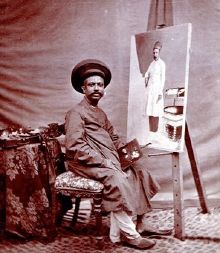Hurrychund Chintamon: Difference between revisions
No edit summary |
No edit summary |
||
| Line 37: | Line 37: | ||
[[Category:Hindus|Chintamon, Hurrychund]] | [[Category:Hindus|Chintamon, Hurrychund]] | ||
[[Category:People|Chintamon, Hurrychund]] | [[Category:People|Chintamon, Hurrychund]] | ||
[[es:Hurrichund Chintamon]] | |||
Latest revision as of 12:46, 18 December 2024
Hurrichund Chintamon was a disciple of Dayanand and President of the Arya Samaj of Bombay in 1878, when the Theosophical Society formed an alliance with the organization. Soon after the Founders arrived in Bombay, they found out Chintamon had mishandled the funds sent by them from the USA and was expelled. He later was an important figure in the formation of the Hermetic Brotherhood of Luxor.
Work in photography
Hurrichund Chintamon was a pioneer of photography in India. Martin W. Sandler wrote:
The early popularity of photography in India, particularly in Bombay, was also due in great measure to the contribution of one pioneer photographer, Hurrychind Chintamon. . . . Chintamon was the most masterful and most successful of the early Indian photographers who captured carte-de-visite images of literary, political, and business figures.[1]
Theosophical involvement
According to the Membership Register of the Theosophical Society, Chintamon was admitted as a member in 1877[2] The Readers Guide to The Mahatma Letters to A. P. Sinnett states:
Chintamon, Hurrychund, a chela of Dayanand of the Arya Samaj movement... While HPB and HSO were still in the USA they had correspondence with him and sent fees to the Arya Samaj through him. It was discovered that he had diverted these funds, amounting to about Rs. 600, to his own pocket. Later he attempted to arouse suspicion of HPB as a "Russian spy." He was expelled from both the TS and the Arya Samaj and decamped to England with Rs. 4,000 belonging to the latter body.</ref>
He was expelled from the Theosophical Society of the Arya Samaj on May 13, 1879.
Towards the end of 1882 Chintamon went to London and met with Mr. Massey. He produced some letters supposed to come from Mme. Blavatsky, incriminating her in the creation of a hoax in relation to the Mahatmas. In October 1882, Master K.H. wrote to A. P. Sinnett:
Hurrychund Chintamon of Bombay, now of Manchester and elsewhere; the man who robbed the Founders and Dayanand of Rs. 4,000, deceived and imposed upon them from the first (so far back as New York), and then, exposed and expelled from the Society ran away to England and is ever since seeking and thirsting for his revenge.[3]
Hurrychund Chintamon never failed once during the last three years to take into his confidence every theosophist he met, pouring into his ears pretended news from Bombay about the duplicity of the Founders; and to spread reports among the spiritualists about Mad. B’s pretended phenomena, showing them all as simply “impudent tricks” — since she has no real idea of the Yoga powers; or again showing letters from her, received by him while she was in America; and in which she is made to advise him to pretend — he is a “Brother” and thus deceive the British theosophists the better . . . H.C. is doing all this and much more[4]
Later years
Hurrychund Chintamon was an important figure in the origination of the "Hermetic Brotherhood of Luxor". Eventually, he was forced to leave England (again for mismanagement of money) and seems to have disappeared in the USA.[5]
Additional resources
- Hurrichund Chintamon at HistoryoftheAdepts.com
- Hurrychund Chintamon in Theosophy World
Notes
- ↑ Martin W. Sandler, (New York: Oxford University Press, Inc, 2002), 32
- ↑ Membership Register. Theosophical Society Adyar Archives.
- ↑ Vicente Hao Chin, Jr., The Mahatma Letters to A.P. Sinnett in chronological sequence No. 92 (Quezon City: Theosophical Publishing House, 1993), 291.
- ↑ Vicente Hao Chin, Jr., The Mahatma Letters to A.P. Sinnett in chronological sequence No. 92 (Quezon City: Theosophical Publishing House, 1993), 291.
- ↑ George E. Linton and Virginia Hanson, eds., Readers Guide to The Mahatma Letters to A. P. Sinnett (Adyar, Chennai, India: Theosophical Publishing House, 1972), 223.
